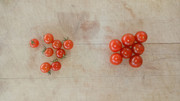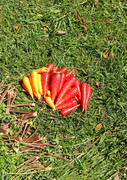1
Tropical Fruit Discussion / Re: Squam and Har in very useful video on powdery mildew
« on: Today at 03:25:40 PM »
I'm seeing a lot of late varieties on the resistant list. I wonder if there is a link there.
The Internet's Finest Tropical Fruit Discussion Forum!
"All discussion content within the forum reflects the views of the individual participants and does not necessarily represent the views held by the Tropical Fruit Forum as an organization."
This section allows you to view all posts made by this member. Note that you can only see posts made in areas you currently have access to.
That is a very good answer except for the last point. Any cutting that can be rooted can be air layered. But not necessarily the other way around.
We commercially layer rambutan, for example. We must get 90% or better. We’d never get that with cuttings if any at all.
Peter
I say that because of Macadamia. I have air layered lychee on a commercial level. When we tried macadamia on a small scale we got callus formation but no roots until we cut them off and treated them like cuttings. Was it a fluke??? I don't know. Also, Atemoya can be rooted from cuttings according to Australian literature. I have never gotten it to air layer successfully because it has weak wood and the layers have always gotten snapped off by wind. In theory it works, but in practice its not practical. That is why I add the caveat.
https://tropicalfruitforum.com/index.php?topic=47077.0 Macadamia can be air layered
Figured that I would be good to report back. The Guthrie plum I purchased from Mail Order Natives in October had a few blooms this year in a 3 gal pot. And we only got 75 hours of chill. Also, Flavorella plumcot bloomed heavily. I was shocked to see how little chill it needed.@galatians522 How is your Flavorella doing these days? Has it fruited these past couple years since you posted about it? Do you find it is adequately pollinated by Scarlet Beauty, or by another tree on your property?
I'm considering giving my Scarlet Beauty a mate, and wonder if Flavorella is an option.
My pears were in Southeast AL, but I brought some scions with me to WA. The Euro ones have yet to fruit, but the Warren is supposed to take some time ~5 years or so to begin fruiting hence the lack of commercial acreage. The Potomac was more than twice as vigorous and is supposed to be more acidic than the Warren. I usually don't allow my trees to fruit until established, at least 3 years of age.
The rootstock should also be blight resistant if you want your trees to be most protected.
We also have a bunch of Bradford pears over here too. I've been curious if I can graft a European pear to one of those that are already established. I'm still doing research so I haven't came to a conclusion yet. I know they're invasive but theres quite a few or here. I've even killed a few too.
Cool, I got your black pink juice canes going in pots, I just need to pop them in the ground now.

We made some drinks yesterday with the Jamaica stripe. This one seems to oxidize a lot less than others. It doesn't really brown at all. Makes the best margaritas. I had a couple bottles of fortaleza put away from back when the stuff was cheap.
My machine holds a half gallon Mason jar nicely and fills it in just a few seconds.

Wow! Sounds like business as usual in latin america. Just out of curiosity, do you know what soil classifications are common in your area?Never checked. I know that our soil is porous red clay or clay sand, it's very unusual and i've never seen soil like this anywhere else. It has all the properties of sand when dry, it breaks into small tiny particles and flows like sand, but when it's wet it becomes totally like clay to a degree you can make dishes out of it. Very porous and light, plants love it. No need to amend as it's very rich in minerals, we just add compost but I don't think even that is needed since the pasture has been amending it with rotting matter, it's also full of worms so no need for vermicompost.


Any idea what's below the Spodic layer?
How many different types or variations of the Florida wild native muscadine is there?
I found a new found interest in some of the Florida hybrids. Finding a source is more difficult than I've anticipated but as far as rootstock I do not have to look far. Is grafting grapevines more difficult than mangoes or avocado?
I'm super excited to try pitangatuba also. My plants have been flowering for their second year so I'm hoping for a few fruits to try. It probably improves all eugenia species fruit flavor. Cranberry hibiscus sounds really interesting and will be trying that today.
Lots of good plants to try improving with the miracle fruits, thanks for all the replies and ideas for us all to experiment with. Keep em coming.
Nice find! I like the map. Another cool one is web soil survey. https://websoilsurvey.nrcs.usda.gov/app/WebSoilSurvey.aspx The photo feature worked this time, so I was able to add pictures to my last post. I'm in entisols with some areas close by with spodosols. Might not be 100 percent accurate since I think my soil is a spodosol. Just one block over the soil looks a bit different. Sandy also, but a bit more rock it seems. D's Fruit Trees uploaded a video of him planting a large nam doc mai mango and I recognized the area. I could see the palms that are in my block on the other side. lol https://www.youtube.com/watch?v=P2nHWktUil8
Thanks for sharing the soil details! I hadn't looked this up before and didn't realize the diversity of soil types. According to FL soil survey map, https://www.arcgis.com/home/webmap/viewer.html?layers=3995a23b3e4541deb336bc1bf9b076d1, I've got the ridge "Tavares sand" which is considered "farmland of unique importance" and a small section of "Arents" soil. No irrigation here but I've always mulched and tried to increase organic matter.